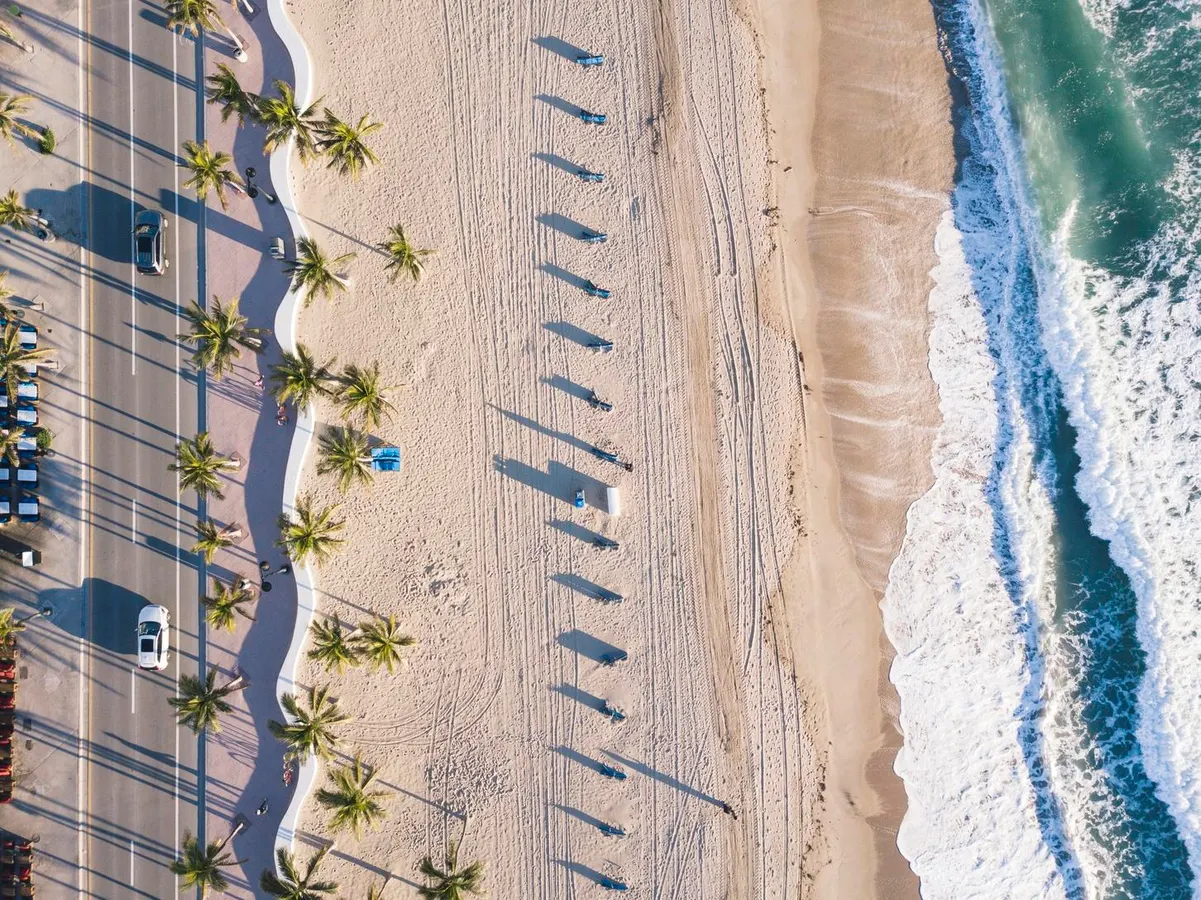By Contributor,Peter Lane Taylor
Copyright forbes

It’s 4:30 pm on a slow, molten Friday afternoon along Las Olas Boulevard, and the closing bell on Wall Street South rumbles out over the canals linking the upscale finger island neighborhood of Seven Isles to the Atlantic Ocean.
At the newly opened Ocean Prime Fort Lauderdale on the Intracoastal Waterway (ICW), a recently christened 49-foot Azimut pirouettes into the dock, Macallan highballs clinking on the gunwale as her crew of 30-something finance bros who’ve just moved here from Manhattan tends the lines. Three slips down, a well-tanned real estate broker in Tom Ford loafers shoves off to show his client a seven-figure pocket listing on a canal in Harbor Beach: five bedrooms, 100’of dockage, private spa with snow shower, and sunrise and city skyline views straight out of an Architectural Digest spread. (The joke among yacht owners here is that everyone’s boat sounds the same regardless of size once you start up the engines: “the-money, the-money, the-money, the-money”).
Elsewhere, the ‘Venice of America’ hums to its new-found rhythm a world away from Miami: sailboats glide down the New River, kayakers jaw at the superyachts arriving from St. Barths, and a steady stream of e-bikes, Segways, and red rental Mustangs winds east to catch the moon rise over Las Olas Beach.
Step back and it’s hard to imagine a more utopian place to buy a house or that anything’s wrong with the real estate market at all.
Fort Lauderdale has more than five times the canals and inland waterways as Venice, Italy, including the Intracoastal Coastal Waterway (ICW).
I first wrote about Fort Lauderdale a few months ago, reporting on several new high-profile residential developments by big national firms that are helping to fuel the city’s post-COVID Renaissance and shifting its identity decidedly upmarket, particularly relative to Miami which has a habit of sucking all the oxygen out the South Florida real estate headlines.
What I didn’t fully grasp at the time, however, was just how clear Fort Lauderdale’s vision for itself and its re-branding was, and how inextricably that vision was tied to the ocean. Given that more and more Americans keep throwing down ever larger piles of money to buy waterfront property these days, that made the city’s scrappy, Cinderella run from spring break party town to front page real estate news a much more intriguing story.
Fort Lauderdale Beach used to be the epicenter of the biggest Spring Break party in America beginning back in the 1930s. It’s now just one part of Fort Lauderdale’s new rebranded identity as a sophisticated, world-class city fueled by water.
Fort Lauderdale’s more than 165 miles of inland waterways and canals make it a purpose-built paradise for sailors and boaters who like to keep their million dollar toys right in their backyards.
Courtesy of Sublime Imagery
In a speech on October 28, 1943 to the British House of Commons after the Parliament building was destroyed by German bombs, Winston Churchill proclaimed to the presiding MPs his now famous aphorism about its reconstruction: “We shape our buildings; thereafter they shape us.”
Almost a century later, Churchill’s quote still perfectly captures not only the power of design, but also why I love writing about real estate. Many people see architecture, buildings, and construction primarily as matters of engineering, economics, or something you buy at Home Depot and hire someone else to install.
Yet, our relationship with the places and spaces where we live, work, and play is far more emotionally and culturally (and politically) complex than that — which is what Churchill was alluding to when he chose the word “shaping”. Not surprisingly, I spend a lot of time looking at real estate development not just as a thing, but also a force, as well as thinking about the ways in which it shapes and reflects us in a broadly Churchillian way.
Downtown Fort Lauderdale is home to dozens of national and international companies, including JP Morgan, Raymond James, AutoNation, and Chewy, creating a diversified economy that also includes marine, technology, and tourism.
Ft. Lauderdale is known as the Venice of America, due to its extensive and intricate canal system. They’re also a great place to park your yacht.
So, a few weeks after I wrote that first story about Fort Lauderdale’s re-evolution, I decided to dig a little deeper into the forces that were actually forging it. Cities peaking in real time can tell us a lot about America’s positions and priorities in the current moment, not just on a personal level, but also when it comes to thornier issues like the wobbly housing market, balancing red state-blue state politics, and staying economically relevant in the age of AI. So, what could the rest of America’s emerging and revitalizing cities learn from the former, unofficial ‘Spring Break Capital of The World’?
In Fort Lauderdale’s case specifically, I also wanted to understand whether anyone was worried about climate change wrecking the party. A Nvidia stock bump and Friday night reservation at Michelin-starred MAASS are all well and good until a Category 5 hurricane takes out the Las Olas drawbridge and your $2 million Hatteras ends up wedged between the palm trees (that does happen).
Yachts moored on canal against cloudy sky at sunset in Las Olas Boulevard, the city’s main thoroughfare lined with canals, luxury yachts, and jaw-dropping waterfront mansions.
Fort Lauderdale Beach.
Let’s start with the obvious: water and boats are the lifeblood of Fort Lauderdale, in a way that’s more innate than in arguably any other American city. Water not only defines the neighborhoods, fuels the economy, and connects the city to the world, but also metaphorically shapes the people who live here the same way mountains and horses make cowboys and ranchers.
The numbers alone are Titanic: over 165 miles of waterways and canals — five times that of Venice, Italy — more than a hundred marinas, the world’s third busiest cruise ship port (Port Everglades), the planet’s largest in-water boat show (Fort Lauderdale International Boat Show), and headquarters for the $36-billion superyacht economy, which helps the city punch significantly above its weight from a global branding standpoint.
Fort Lauderdale’s intricately planned canal system combined with over seven miles of Atlantic oceanfront also make it arguably Florida’s most coveted luxury market for detached waterfront real estate, particularly where dockage and direct access to the ocean are concerned. Although Miami by sheer size and vertical density has far more multi-million dollar mansions and condos overall, Fort Lauderdale is a purpose-built paradise for sailors and anglers who prefer to park their seven figure, diesel-powered, carbon fiber toys in their backyards and be three miles offshore in under an hour when the marlin are running.
Fort Lauderdale’s canals and inland waterways offer direct access to the ocean from thousands of ultra-luxury houses along with private waterfront dockage.
Fort Lauderdale is the de facto global capital of the superyacht industry.
Not surprisingly, Fort Lauderdale’s relatively affordable real estate has been doing pretty well without having to do much at all since even before the pandemic. As the stock market and housing values have soared over the past decade, outside money has poured in; and not just from the typical sources like New York, California, and the Midwest, but also from Miami just thirty miles south, where asking prices for a Star Island tear-down until recently could buy two adjoining, street-to-beach, oceanfront mansions in Lauderdale Beach with enough left over to sail around the world.
“Water defines Fort Lauderdale and waterfront affordability is one of Fort Lauderdale’s major draws,” says Dev Motwani, Managing Partner at his family’s real estate firm, Merrimac Ventures, and Chair of the Fort Lauderdale Downtown Development Authority, which just launched its Fueled By Water initiative. “We’re vibrant, yet approachable, sophisticated yet inviting. We have a lifestyle like no other, walkable urban districts, scenic waterfronts, and the entire downtown area has outpaced county, state, and national benchmarks by most economic growth metrics. Yet, we have real estate options that fit a range of buyers, even though South Florida is still a premium market. Add in no state income tax and a business-friendly environment, and it’s easy to see why people and families want to live, work, and invest here.”
Downtown Fort Lauderdale is booming within the limited amount of land and development sites it has left. This ‘scarcity’ is driving the city’s tight commercial real estate market while other cities are still struggling to keep office buildings filled.
Ocean Prime Fort Lauderdale
Courtesy of Cameron Mitchell Restaurants/Ocean Prime
Anglins Fishing Pier.
Sensing that Fort Lauderdale is on the verge of its ‘moment’, most of South Florida’s biggest real estate developers, including Motwani’s Merrimac, have pounced on the rising tide here, putting both their names and big numbers behind a city of barely 197,000 residents that was as recently as a few decades ago still better known for wet t-shirt contests than a Michelin-starred culinary scene.
Case in point is Fort Lauderdale’s downtown waterfront at the confluence of the ICW and the New River, where more than $12 billion of projects are underway including the rebirth of Pier Sixty-Six; a $2 billion resurrection of Bahia Mar and the St. Regis Resort & Residences; a 20-year, $3 billion expansion of Port Everglades that will cement Greater Fort Lauderdale as a global player in the cruise, cargo, and energy industries; and a steady surge of new luxury branded residential towers from billion dollar, national players like Property Markets Group (PMG) and Related Group. Never one to miss out on a trend, Fort Lauderdale is now home to The FORT at Snyder Park, the world’s first pickleball stadium complex strategically located next to Fort Lauderdale International Airport to drown out 43 courts of “thwock”.
Ariel direct overhead shot of luxury Super yachts lit at night Fort Lauderdale international boat show
Fort Lauderdale, Florida, USA skyline at dusk.
The theory behind all of this development fueled by Fort Lauderdale’s connection to the water is that in addition to stimulating a new wave of downtown residents, it will also initiate an emerging knowledge-based economy on top of the city’s traditional marine and tourism industries — which, in turn, creates diversity and sustainability when it comes to long-term growth.
“Fort Lauderdale’s waterways shape not only how people want to live, but also where companies want to place their teams and relocate their executives these days,” says Tere Blanca, Founder and CEO of Blanca Commercial Real Estate, about the city’s re-branding and revitalization. “In Downtown Fort Lauderdale, for example, you see it show up in fundamentals that support recruiting and retention. Top-tier Class A office buildings are averaging in the high $50s per square foot and trophy space can reach into the mid-$70s. That’s meaningful pricing power for a compact business district. And with only one new office building under construction — T3 FAT Village, delivering in 2026 — demand stays focused on a small set of best-located assets near transit, amenities, and the waterfront.”
In layman’s terms, that’s real estate lexicon for scarcity, and in Fort Lauderdale’s case, what that means is that there’s only so much water-adjacent office space available and the only way to add more supply is to build vertically or re-purpose what’s already there, which is precisely what’s happening in FAT Village as well as Pier Sixty-Six and Bahia Mar.
“We’re a midsize market with very limited room to grow,” says Motwani. “Broward County is nearly fully developed, and space in the Central Business District around Las Olas for new office buildings is extremely limited. That’s why Hines and Urban Street Development turned to FAT Village just north of downtown for their T3 office building. This scarcity is exactly what makes waterfront redevelopment here a smart long-term investment and bodes well for our real estate market overall.”
Hines’ $500 million FAT Village development will reinvigorate Fort Lauderdale’s historic arts district at Flagler Village.
Courtesy of Binyan Studios
Water in Fort Lauderdale is not simply a tourism attraction or a real estate amentity: it’s an organizing principle for the city’s identity and economy.
Courtesy of Fort Lauderdale DDA
Fort Lauderdale’s hidden-gem, boho-riche, oceanfront lifestyle pitch is also paying off, especially as Miami’s unrestrainable growth starts to eat further at its own tail. Michelin’s arrival this year blew open a culinary scene locals already knew; back-to-back Stanley Cups by the Florida Panthers put a national spotlight on the region’s sports economy and poured tens of millions into local businesses; and the Fort Lauderdale International Boat Show has opened the world’s eyes to the city’s global roots.
“All of these things are part of Fort Lauderdale’s business card,” says Blanca. “And the boat show specifically gives us the chance to reach an international audience because the conversation is as much about deals as it is about yachts. Executives come in, experience the waterfront, see high-end offices and residential neighborhoods, 5-star hotels and restaurants steps from the beach and the marinas, and the market reframes itself. That reputational impact often shortens the distance between a first visit and someone who eventually puts down roots here.”
The two-tower Viceroy Residences will be Fort Lauderdale’s first luxury branded residential building and is the most visible validation yet of Fort Lauderdale’s rising prestige.
Courtesy of Hayes Davidson
Not surprisingly, as Fort Lauderdale’s cultural cache has trended upmarket and word has spread, the corporate logos have followed, even as Miami and West Palm Beach have gotten the headlines for pulling in the higher-profile whales like Citadel and Goldman Sachs. The recently re-branded Napster Corporation, for example, has plans for a massive 60-acre, 100,000 sf entertainment campus here, while JP Morgan Private Bank, Raymond James, AutoNation, Citrix, Chewy, and $100-billion asset manager GQG Partners are also eating up ever larger amounts of prime office space. For the CEOs of these companies, the pitch to the C-suite is simple: live on the Intracoastal, take the water taxi to work, and be wheels-up to Boston or Bimini from Fort Lauderdale-Hollywood International within fifteen minutes.
“Fort Lauderdale stands out for the way it combines lifestyle with opportunity, and vibrancy and ease,” says Russell Galbut, founder and CEO of national developer, GFO Investments. “Downtown blends a relaxed coastal setting with the cultural energy of a dynamic urban center. Families and companies continue to move in, and few cities can match our balance of year-round sunshine, world-class water access, and a full calendar of cultural, sports, and entertainment experiences. What makes this even more compelling is that Fort Lauderdale is still relatively young, with significant potential to grow and continue strengthening South Florida’s reputation for the right reasons.”
Twilight at the Fort Lauderdale International Boat Show says all you need to know about the forces of water shaping the city’s identity and economic future.
All of this momentum and boosterism bodes well for developers like Galbut and Motwani, especially since other mid-sized Florida cities like Tampa, St. Petersburg, and Orlando are undergoing similar Renaissances for similar reasons and competing for a lot of the same low hanging fruit.
But developers and investors here also have the numbers to back it up: downtown Fort Lauderdale’s current annual economic impact, for instance, is estimated at $43 billion, up roughly 44% since 2019. Real-estate development impact has grown about 30% in that same window to $5.7 billion. Countywide business activity tied to the core supports well over 200,000 jobs. And since 2018, the number of families with children moving downtown has surged more than 80%.
“Fort Lauderdale offers the best of both worlds,” says Rajiv Jain, Chairman and CIO at GQG Partners, which also happens to be one of Fort Lauderdale’s own home-grown financial powerhouses. “Suburban living combined with the proximity of Miami just 30 miles away. Direct flights to New York City, but without the hustle and bustle. An affordable cost of living and family-friendly atmosphere with a vibrant downtown. And a lot of our employees walk to work. There’s also a strong sense of community here, with collaboration between businesses, non-profits, and academic institutions and the feeling that we are all part of a larger ecosystem.”
Downtown Fort Lauderdale and the Intracoastal Waterway at dusk.
Zooming even farther out, a city like Fort Lauderdale whose essential identity and economy are fueled by water isn’t without risk. Betting long on global climate change and sea level rise when you live inches above flood level at high tide is a wildly uncertain proposition no matter whose data you use or how you interpret it. Then there’s the whole more practical, fiduciary matter of insurability, and whether the federal government will continue to provide a net of last resort to live in places we probably shouldn’t have been building homes in the first place.
Ultimately, the reality for cities like Fort Lauderdale (and the rest of Florida and America’s coasts) is that stronger storms bring heavier rain and longer stalls, floods push farther inland, and low-lying neighborhoods and commercial corridors that were once considered safe aren’t anymore because they were built for a different century. Climate risks are real; the appetite for waterfront real estate, however, is greater.
Fueled by water. An aerial view of Fort Lauderdale.
A Fort Lauderdale street floods in a residential neighborhood from Tropical Storm Eta.
This the paradox in 2025. While national housing data looks ragged around the edges and the news cycle seems to report weekly on yet another climate-fueled natural disaster, the most coveted ribbons of America’s coastal real estate are still in high demand. And in cities like Fort Lauderdale specifically, the utopian lure of the 24/7 live-work-play waterfront lifestyle isn’t going anywhere any time soon. If anything, it’s being validated and perfected here.
Risk, as it turns out, has a way of clarifying taste and encouraging adoption. Buyers are warier now of flood plain maps. Developers like Galbut, Motwani, PMG, and Related Group are specifying impact resistant glass, elevating critical mechanical systems, and designing artificial dune systems and landscaping around their projects to break and absorb potential storm surges. And at the municipal level, cities are elevating roads, fortifying utilities, and using parks and other public spaces as dual-purpose amenities and buffers.
“Fort Lauderdale’s future is tied to the water and resilience is at the heart of our strategy,” says Fort Lauderdale Mayor Dean Trantalis. “Through Fortify Lauderdale, we’re investing more than $1.6 billion across the city to reduce flooding, address sea-level rise, and prepare for stronger storms. This isn’t a one-neighborhood fix. It’s a citywide plan already delivering results. Every pipe, every drainage structure, and every pump station is being built and maintained to perform when the next storm comes. By pairing this infrastructure with our waterfront identity, we’re showing how a city can protect its natural assets while creating new economic opportunity, and proving that growth and sustainability can advance together. That balance will define Fort Lauderdale in the years ahead.”
Sunrise in Fort Lauderdale.
Waterfront real estate will always be a study in contradictions, and in this sense, Fort Lauderdale will always be a visual, physical proving ground for it, hemmed in my two unstoppable forces: the ocean and humanity’s desire to live by it. As a result, watching what happens here as both continue to shape one another will tell us a lot about ourselves, our politics, our respect for nature, and the power of design in a way that hopefully even Churchill would have considered worthy.
Editorial StandardsReprints & Permissions



